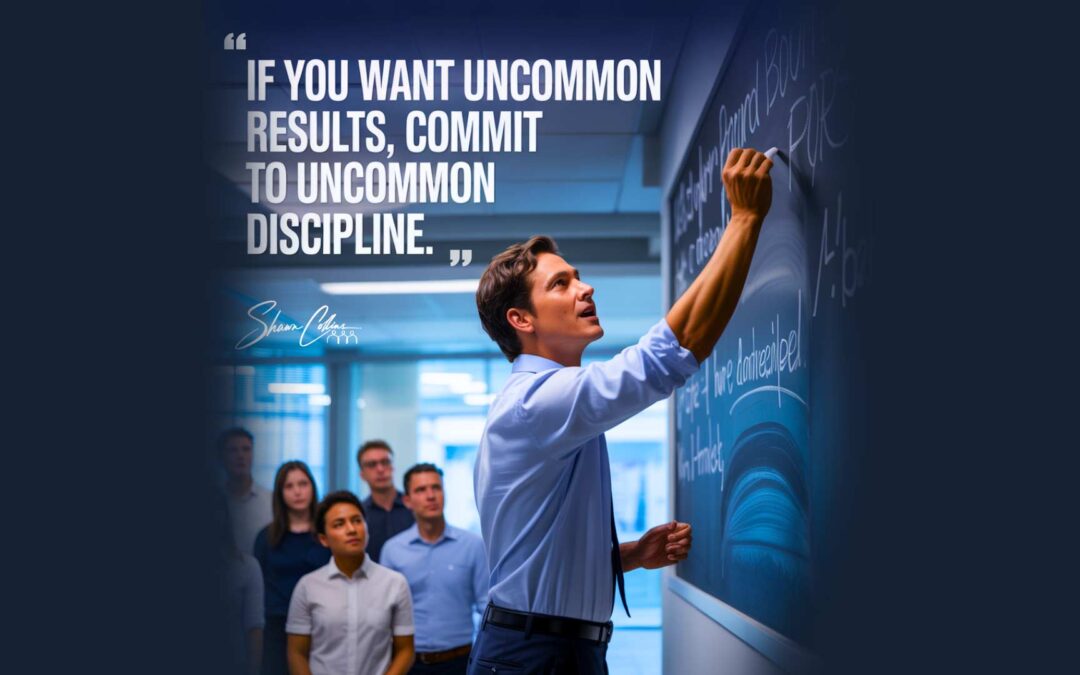“If you want uncommon results, commit to uncommon discipline.”
If you want uncommon results, commit to uncommon discipline. This statement isn’t just motivational fluff; it’s a fundamental truth in business leadership. As a C-suite executive, you’re navigating a landscape cluttered with competitors, technological disruptions, and shifting market demands. To not just keep pace but to excel, you need to understand what uncommon results actually look like and why traditional methods of discipline are no longer sufficient.
Uncommon results can be defined as significant, outlier achievements that place your organization ahead of the competition. Think of these as the milestones that most companies only dream of reaching. This could be breaking into new markets, generating record-breaking profits, or fostering a company culture that attracts and retains top talent. These results aren’t incidental; they are the consequences of a leadership approach rooted in rigorous, uncommon discipline.
Yet, here’s the catch: traditional discipline methods often fall short for executives. They tend to prioritize compliance over creative execution. They encourage adherence to existing protocols rather than fostering a culture of innovation and flexibility. In a world where agility is key, sticking to standard practices can inhibit growth and responsiveness. C-suite executives must recognize that to achieve uncommon results, their approach to discipline needs to evolve as well.
In the upcoming sections, we’ll explore how to cultivate this uncommon discipline, address the challenges you face, and highlight actionable strategies tailored for executives eager to outperform their competition. Your journey towards exceptional outcomes starts with a commitment to rethinking your discipline strategy.
Understanding the Concept of Uncommon Discipline
To achieve significant breakthroughs in leadership, you need more than just conventional discipline. You need uncommon discipline, a concept that goes beyond rigid adherence to rules. It’s about cultivating a mindset and a set of habits that drive remarkable performance consistently.
The Mindset Shift
Uncommon discipline starts with a fundamental shift in how you perceive challenges. Instead of seeing obstacles as roadblocks, view them as opportunities for growth. This perspective enables you to push boundaries and explore innovative solutions. Cultivating this mindset demands a willingness to embrace discomfort and uncertainty, both of which are inevitable in today’s fast-paced business landscape.
Establishing Habits That Matter
Your habits define your effectiveness as a leader. Uncommon discipline involves establishing routines that prioritize high-impact activities. This means investing your time and energy into tasks that truly drive value for your organization. Think about how you allocate your day: are you caught up in the endless cycle of meetings, or are you strategically setting aside time for deep work that propels your vision forward?
The Role of Consistency
Without consistency, even the best habits can falter. Uncommon discipline requires you to commit to your routines day in and day out, regardless of the pressures you face. This consistency creates a rhythm that fosters trust and reliability within your team. When your team sees you steadfastly sticking to your principles, they’re more likely to mirror that commitment, leading to a culture of discipline throughout your organization.
In summary, uncommon discipline is not about being rigid; it’s about being adaptable while maintaining a strong foundation of habits, mindset, and consistency. It requires a proactive approach to leadership that sets the stage for extraordinary results. As we progress through this discussion, keep in mind that the journey to uncommon discipline is essential for outperforming the competition and achieving your organizational goals.
Challenges Faced by Executives in Committing to Uncommon Discipline
Committing to uncommon discipline isn’t just a matter of willpower; it’s a complex undertaking laden with challenges. As a C-suite executive, you’re often caught between the demands of daily operations and your long-term vision. Understanding the obstacles in your path can prepare you to face them head-on and build the resilience needed to maintain your commitment to discipline.
Time Constraints
The clock is always ticking, and as a leader, you’re pulled in multiple directions. Time constraints often force you to choose between immediate tasks and strategic initiatives. You might find yourself spending more time on urgent matters than on shaping your executive discipline. This scarcity of time can hinder your ability to invest in the high-impact routines that matter.
Decision Fatigue
Every day choices add up, leading to decision fatigue that can cloud judgment and stifle your effectiveness. When you’re faced with a myriad of decisions, it’s easy to let discipline slide in favor of what feels easier or more familiar. This fatigue compromises your ability to focus on the disciplined habits necessary for achieving uncommon results and impacts your long-term strategic thinking.
Organizational Resistance
Implementing a culture of uncommon discipline often meets resistance. Teams accustomed to a certain way of operating may resist new expectations or routines. This can lead to disarray and frustration, making it difficult for you to foster the discipline that drives exceptional performance. Challenging the status quo requires tenacity and the ability to communicate your vision effectively.
Balancing Short-term Demands with Long-term Vision
Navigating the tension between short-term results and long-term objectives can be a challenging task. Executives are often under pressure to deliver immediate results, which can divert focus away from the disciplined actions required to achieve broader, long-term goals. Remember, maintaining uncommon discipline is about creating pathways for sustainable success, not just quick wins.
Recognizing these challenges is the first step in overcoming them. Each obstacle can serve as a lesson in resilience for you and your organization. The goal is not merely to acknowledge the difficulties, but to develop strategies that not only minimize their impact but also support your commitment to uncommon discipline.
The Impact of Uncommon Discipline on Business Outcomes
Executives who commit to uncommon discipline don’t just set their organizations apart; they drive remarkable business outcomes. The relationship between discipline and performance is clear: when leaders adopt a disciplined approach, the benefits echo through every level of the organization. Let’s explore how this commitment translates into tangible results.
Case Study: The Technology Firm That Innovated
A leading technology firm implemented rigorous discipline in their development processes. By prioritizing high-impact projects and adhering to defined routines, they drastically reduced their product development cycle from 18 months to just 6. This shift enabled them to launch innovative products faster than competitors, resulting in a 40% increase in market share within two years. Their disciplined approach not only facilitated innovation but also improved team cohesion, as members felt empowered under a structured framework.
The Data Speaks
Research consistently shows that executives who are disciplined yield superior results. A recent study found that organizations led by disciplined executives experience 30% higher employee engagement scores, leading to greater productivity and retention. Engaged employees are more likely to contribute ideas and go the extra mile, creating a culture of ownership and responsibility.
Shareholder Value and Financial Performance
Uncommon discipline doesn’t just alter internal dynamics; it enhances shareholder value too. Data from multiple industries indicates that companies with disciplined leadership outperform their peers in total shareholder return by an average of 20% over five years. This improvement comes from strategic investments in growth initiatives, efficient resource allocation, and a clear focus on long-term objectives—all hallmarks of disciplined leadership.
Encouraging a Culture of Discipline
When executives model uncommon discipline, it often cascades through the organization. For instance, a financial services company with a disciplined approach saw its departmental managers adopting similar practices. This alignment led to a 15% increase in operational efficiency and an uplift in employee morale, as teams felt more aligned with corporate goals. The benefits are not just quantitative; they foster a deeper commitment to the organization’s mission.
The evidence is clear: uncommon discipline is a catalyst for superior business outcomes. Executives who champion this mindset and set a precedent for their teams not only achieve more but also inspire those around them to strive for excellence. Keep this in mind as we delve into practical strategies to cultivate your discipline and reap the benefits.
Strategies to Cultivate Uncommon Discipline
Ready to elevate your leadership and performance? Cultivating uncommon discipline isn’t just about personal resolve—it requires structured strategies that can be woven into the fabric of your organization. Here’s how you can start implementing effective practices right away.
Establish High-Impact Routines
Your daily habits can either propel you forward or hold you back. Establish routines that focus on what matters most. This means identifying and prioritizing activities that directly drive your strategic objectives. Consider these steps:
- Identify key priorities: What tasks will drive the most value? Align your routines around these priorities.
- Ditch low-value meetings: Reduce time spent in meetings that don’t have a clear purpose. Instead, reserve that time for focused work that advances your goals.
- Schedule time blocks: Allocate specific time blocks in your calendar for deep work and strategic thinking, away from daily distractions.
These simple shifts allow you to invest your energy into activities that create tangible results.
Leverage Accountability Systems
Accountability is a powerful motivator. Establish systems that reinforce your commitment to uncommon discipline:
- Peer partnerships: Collaborate with other executives or leaders who share your commitment to discipline. Regularly check in with one another to stay on track.
- Performance metrics: Set clear, measurable goals and track your progress. Use visual dashboards or scorecards to stay accountable and motivated.
- Feedback loops: Create an environment where constructive feedback is welcomed. This helps you refine your approach and maintains a sense of accountability.
By cultivating a culture of accountability, you reinforce your commitment and inspire similar behavior in your teams.
Prioritize Self-Development
As a leader, your growth should never stagnate. Invest in yourself as part of your uncommon discipline strategy:
- Continuous learning: Engage in leadership training, industry workshops, or relevant courses. Keep yourself informed about emerging trends and challenges in your field.
- Mentorship: Seek out mentors who challenge you to think differently and push your boundaries. Their experience can help you navigate your own path to disciplined leadership.
- Reflective practice: Make it a habit to spend time reflecting on your decisions and actions. Ask yourself: what worked, what didn’t, and how can I improve?
Prioritizing your development not only benefits you but also sets an example for your organization.
Fostering a Culture of Discipline
Uncommon discipline is not just about individual efforts—it’s about creating an environment that supports and reinforces disciplined practices across your organization:
- Communicate expectations: Clearly articulate the importance of discipline and how it ties to the company’s goals. Make sure your team understands the “why” behind disciplined actions.
- Recognize achievements: Celebrate milestones that reflect your discipline strategy. Acknowledge team members who exemplify disciplined behaviors, reinforcing the importance of commitment.
- Encourage autonomy: Give your team the freedom to implement their own routines within the framework of common goals. This fosters a sense of ownership and responsibility.
A culture of discipline becomes self-sustaining when leaders actively promote it, creating an environment where excellence is the norm.
By implementing these strategies, you not only enhance your own leadership capacity but also inspire your organization to pursue uncommon results through shared commitment and discipline. As you adapt these practices, remember that consistency is key. Your role as a leader is to model these strategies, setting the stage for extraordinary outcomes that stretch beyond conventional limits.
Tools and Resources for Maintaining Discipline
In the quest for uncommon discipline, leveraging the right tools and resources can make all the difference. As C-suite executives, you need solutions that not only support your discipline but also enhance your overall performance. Here are some essential categories to consider.
Technology Solutions
Utilizing technology effectively can streamline your operations and reinforce discipline. Here are some tools to explore:
- Project Management Software: Tools like Asana, Trello, or Monday.com can help you manage tasks, set deadlines, and keep your team on track, ensuring everyone adheres to disciplined workflows.
- Time Management Apps: Apps like RescueTime or Toggl enable you to track your time usage, pinpoint areas for improvement, and ensure you’re focused on high-impact activities.
- Collaboration Platforms: Solutions like Slack or Microsoft Teams facilitate communication and accountability within your teams, reinforcing the importance of discipline in daily interactions.
Leadership Coaching
Engaging a leadership coach is a powerful investment in your personal discipline. Consider these factors:
- Expert Guidance: A coach can provide tailored strategies that align with your unique challenges and goals, offering actionable insights to sharpen your discipline.
- Accountability: Regular sessions with a coach establish a framework for accountability, pushing you to stay disciplined in your leadership practices.
- Developing Skills: Coaching can help you refine essential leadership skills, from decision-making to emotional intelligence, both of which are crucial for sustaining discipline.
Time Management Frameworks
Implementing structured time management frameworks can bolster your effectiveness as a disciplined leader:
- The Eisenhower Matrix: This tool helps you prioritize tasks based on urgency and importance. Focus on what genuinely drives your strategic objectives rather than getting caught in busywork.
- The Pomodoro Technique: This method involves working in focused sprints followed by short breaks. It enhances productivity and maintains your concentration, making disciplined work more manageable.
- Time Blocking: Schedule blocks in your calendar for specific activities, ensuring you allocate time for strategic thinking and high-priority tasks amidst your other commitments.
Wellness Practices
Maintaining your discipline isn’t solely about work; it involves taking care of your mind and body. Here are some wellness practices to integrate:
- Mindfulness and Meditation: Regular mindfulness practices can improve focus and reduce stress, helping you maintain the mental clarity needed for disciplined decision-making.
- Regular Exercise: Incorporating physical activity into your routine boosts not only your health but also your cognitive functions, enabling you to tackle challenges with greater effectiveness.
- Healthy Eating: A balanced diet fuels your body and mind. Nutrition impacts your energy levels and cognitive capabilities, supporting sustained discipline in your work.
Incorporating a blend of technology, coaching, structured frameworks, and wellness practices creates a robust support system. This combination helps you remain committed to your uncommon discipline and drives you toward achieving exceptional business results. Remember, discipline is a journey, not just a destination, and the resources at your disposal can make that journey more manageable and rewarding.
Measuring Progress and Adapting Discipline Strategies
To truly thrive with uncommon discipline, you must continuously measure your progress and adapt your strategies. This isn’t a one-time exercise; it’s a relentless commitment to improvement that defines great leadership. As C-suite executives, monitoring your discipline is as vital as tracking financial performance. Here’s how you can effectively measure progress and pivot when necessary.
Setting Measurable Milestones
The first step in maintaining discipline is establishing clear, measurable milestones. These benchmarks serve as tangible indicators of your progress and keep you aligned with your long-term goals:
- Define Specific Goals: Your milestones should be clear and actionable. Instead of a vague goal like “improve productivity,” specify a target such as “increase team output by 15% over the next quarter.”
- Time-frames Matter: Assign deadlines to each milestone. This creates urgency and motivates you to stay accountable, ensuring that you’re consistently advancing towards your objectives.
- Quantitative and Qualitative Measures: Use a blend of metrics. Quantitative data like sales figures or project completion rates, alongside qualitative feedback from team members, provides a holistic view of your discipline’s effectiveness.
With well-defined milestones, you can track progress and identify patterns that signal success or areas for improvement.
Regular Performance Reviews
Consistent reviews of your performance are crucial for sustaining uncommon discipline:
- Schedule Check-ins: Establish a regular cadence for performance reviews, whether monthly or quarterly. Use this time to assess what’s working and what isn’t.
- Gather Feedback: Solicit insights from your peers and team members about your discipline strategies. Their perspectives can illuminate blind spots and offer new ideas.
- Review Your Metrics: Revisit the milestones you set. Are you on track? If not, analyze why. Are the goals realistic? Is there resistance or lack of engagement from your team?
Regular reviews foster a culture of transparency and accountability, ensuring that discipline remains a priority at all levels.
Adapting Approaches for Continuous Improvement
Even the most disciplined leaders need to pivot. The business environment is fluid, and your strategies must remain flexible:
- Be Open to Change: If you find that specific strategies aren’t yielding results, don’t hesitate to adjust them. Adaptation is a sign of strength, not weakness.
- Stay Informed: Keep abreast of industry trends and best practices. Learning from others’ successes and failures can guide your adaptations.
- Refine Your Techniques: Use insights gained from performance reviews to fine-tune your approach. Amend routines, adjust goals, or incorporate new tools that enhance your discipline practice.
A willingness to adapt helps you maintain resilience, focus, and clarity in your leadership, allowing you to pursue extraordinary results.
In essence, the process of measuring progress and adapting strategies is crucial for sustaining uncommon discipline. By committing to regular evaluations and adjustments, you ensure that your leadership consistently drives toward exceptional outcomes. Success in this area not only reflects on your abilities as a leader but also has a ripple effect, inspiring your teams to strive for the same level of dedication and excellence. Your conscious effort to measure and adapt sets a powerful precedent for everyone in your organization.
Conclusion and Call to Action
The connection between committing to uncommon discipline and achieving uncommon results is undeniable. As a C-suite executive, you’re in a unique position to spearhead a movement within your organization that prioritizes rigorous, disciplined practices. This commitment isn’t just a pathway to individual success; it sets the tone for your entire leadership team and can drive transformation across the business.
Consider the stakes: the decisions you make today shape the future trajectory of your organization. When you embrace uncommon discipline, you’re not only defining a standard for yourself but also inspiring your team to elevate their performance. The reality is that organizations led by disciplined leaders often outpace their competitors in innovation, employee satisfaction, and financial performance.
Now is the time to take decisive action. Reflect on your current approach to discipline. Are you merely reacting to the demands of the day, or are you actively crafting a disciplined leadership strategy? The difference lies in your willingness to step outside the conventional mindset and commit to a routine that demands consistency, accountability, and a focus on high-impact activities.
Start by setting specific, measurable goals for yourself and your team. Conduct regular performance reviews to assess progress and make necessary adjustments. Create an environment where discipline is not only expected but celebrated. Your commitment to uncommon discipline will create a foundation for success that will ripple effects throughout your organization.
Take the first step today. Empower yourself and your team by prioritizing uncommon discipline in your daily operations. You have the chance to redefine what’s possible for your organization and achieve results that stand out in your industry. The journey to extraordinary outcomes starts with your commitment—make it today. Your leadership can drive this change, and the results will speak for themselves.




